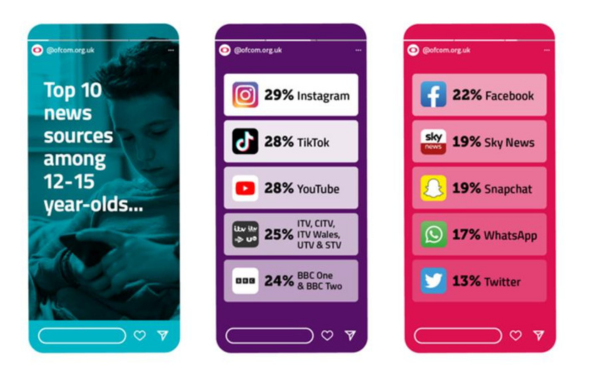
Instagram, TikTok and YouTube now lead the way as news providers for kids and teens in Britain. Their algorithms shape young people’s perception of the world.
And there’s a catch. TikTok’s algorithms, like a strict librarian, often hand out a very narrow range of books to read.
These platforms remind us of how powerful algorithms are. They shape what we see, like choosing our glasses for us. And algorithms, while considered innovative, are subtly molding the worldview of our minds, and it’s not always healthy for our wellbeing.
TikTok’s meteoric rise as a news outlet has been eye-catching. However, the very same algorithms that make TikTok appealing also trap people in a narrow content funnel, limiting exposure to a diverse range of information.
Similarly, YouTube and Instagram also use algorithms to shape content and perceptions. These algorithms create content bubbles, effectively creating echo chambers. And giving rise to influencers.
News Providers or Algorithms?
This goes to show the role algorithms play in shaping our worldview, especially among more impressionable minds. They are most susceptible to these personalized content streams, as they’re in the critical phase of making sense of the world.
We can’t ignore the need for more awareness of what is needed right now. Yes, the road ahead is steep and rocky, but it’s an opportunity calling us. For the sake of our young generation’s mental health and their need for a healthy worldview, can we create new paradigms for education and healthy connection?
One approach could be designing real social networks that promote active engagement rather than passive consumption. Imagine online spaces that encourage dialogue, and exploration of diverse viewpoints, much like an open forum or town square. Even bringing back dinners where we sit around and talk openly.
Furthermore, digital literacy education can become a key part of the curriculum. Could this empower young people to understand how algorithms work, equipping them to navigate their digital environment consciously?
In addition, we can require platforms to disclose their algorithms function, or even provide us with options to customize our content feed so we are in charge.
Playing A Role
Parents and caregivers also play a vital role. They foster healthy habits by encouraging open conversations about the world.
In the end, can we shift the role of young people from mere spectators to engaged, informed contributors? And nurture a healthier, more balanced landscape for our young minds and hearts.
There’s also a valuable lesson here for all of us too. We reclaim our roles as powerful creators, not just passive consumers. We rise above the constant bombardment of fear-driven news and influencer marketing.
Imagine what kids will want to create if they no longer aspired to be TikTok famous.
Instead, let’s author our own news. Let’s ask tough questions, challenge the status quo, and not shy away from open discussions. Let’s value curiosity over conformity. In doing so, we create a healthier ecosystem, and remember the true potential of our collective prowess.
Who is building the next generation communities that actually matter; weaving us together as creators?

